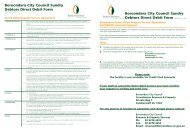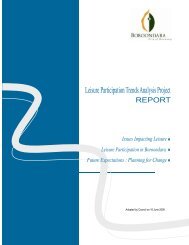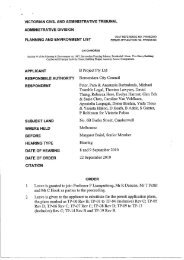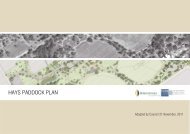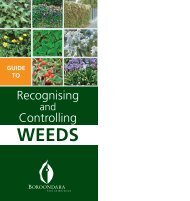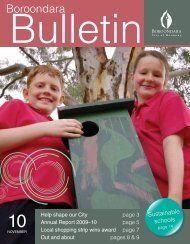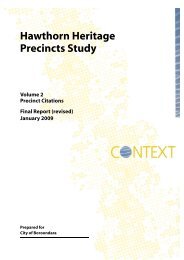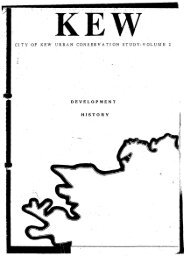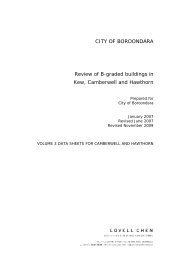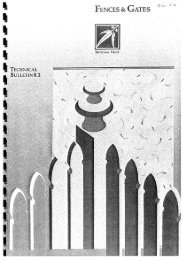Camberwell Conservation Study 1991 Vol 3 - City of Boroondara
Camberwell Conservation Study 1991 Vol 3 - City of Boroondara
Camberwell Conservation Study 1991 Vol 3 - City of Boroondara
You also want an ePaper? Increase the reach of your titles
YUMPU automatically turns print PDFs into web optimized ePapers that Google loves.
<strong>Camberwell</strong> <strong>Conservation</strong> <strong>Study</strong> <strong>1991</strong>- Significant Areas<br />
Precinct 17, Avenue Athol Street period expression <strong>of</strong> sites (expressed as,a percentage<br />
<strong>of</strong> the whole street) from the era 1916-40 is 62% (or<br />
History<br />
The Avenue Athol did not existin the MMBW 1904plan.<br />
76% <strong>of</strong> identified sites only) with those from theVictorian<br />
& Edwardian Era (pre 1915) are 18% (23% identified<br />
Mangarra Road fell short <strong>of</strong> Mont Albert Road and only sites only)", The percentage <strong>of</strong> identified sites from the<br />
Rubens Grove ran the full distance between Canterbury<br />
and Mont Albert Roads. Largely vacant land ran between.<br />
core development era (1900-1930)is 92%.<br />
l Local resident surveyor-architect, Henry Parsons,<br />
surveyed Avenue Athol through this gap in 1906.<br />
Description<br />
2 AvenueAthol<br />
Parsons, himself, lived in Kintore Street. 3<br />
The street contains mainly Edwardian houses, many <strong>of</strong><br />
Subsequent development was dominantly from the uncharacteristic (for <strong>Camberwell</strong>) timber construction,<br />
Edwardian era for the south end, near the East with some brick. There is also intrusive modem devel<br />
<strong>Camberwell</strong> Railway Station, while 1930s housing predominated<br />
at the other end <strong>of</strong> the street.<br />
opment, No. 7 being an example. Visually compatible<br />
4<br />
with this Edwardian housing is the Bungalow develop<br />
One notable resident, at the north end, was Brigadier ment which occurs further to the north on the commence<br />
Alwyn R. Garrett, who lived at 30 Avenue Athol in the ment <strong>of</strong> the concrete roadway. Here the Bungalow<br />
1940s. 5<br />
character becomes quite dominant. This character includes<br />
late 1920sIndian Bungalow and some Italian Villa<br />
AVENUEATHOL· CONCRETE ROAD, PATHWAYS ANDKERBS, OF THE BUNGALOWSECTION OF THE STREET<br />
1 MMBWRP70<br />
2 LP474l; DI900. Henry Parsons <strong>of</strong> George Parsons & Son<br />
3 ibid.<br />
4 see Site Schedule<br />
5 WWA 1944;D1944-5<br />
6 from 1986site schedule analysis



